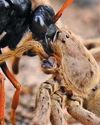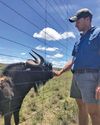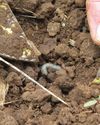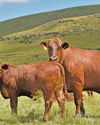Try GOLD - Free
The A to Z of internal parasites in cattle
Farmer's Weekly
|October24 -31, 2025
Internal parasites can cause a loss of production and even death if severe enough. Integrated parasite management is essential for effective control. Janine Ryan reports.
-
For centuries, farmers have been waging war against internal and external parasites.
Internal parasites, at their worst, can cause severe damage to a herd or flock, resulting in fatalities and leading to economic losses.
At best, internal parasites are a nuisance that can lead to a drop in production and negatively impact animals’ welfare. Moreover, parasites, whether internal or external, are a scourge on all farmers, regardless of whether they produce cattle, sheep, goats, horses, chickens, or pigs.
In this article, we take a look at the common internal parasites of cattle. Our list is by no means exhaustive, and should not be used as an alternative to seeking medical attention for animals that are infected with internal parasites. We also provide tables of the common internal parasites of sheep, goats, horses, chickens and pigs.
WIREWORM
Seven of the most common internal parasites of cattle include wireworm (Haemonchus placei), brown stomach worm (Ostertagia ostertagi), black scour worm (Trichostrongylus spp.), small intestinal worm (Cooperia spp.), liver fluke (Fasciola hepatica), and rumen fluke (Paramphistomum spp.).
While wireworm primarily impacts cattle, it never exclusively targets cattle, and sheep and goat farmers should similarly be wary of this parasite.
Wireworm is a roundworm, which resides in the abomasum (‘fourth stomach’) of cattle. Infected cattle pass wireworm eggs in their faeces, which hatch into larvae that develop on the land.
Other cattle then ingest infective L3 larvae (the infective stage of larvae’s life cycle) while grazing, which mature into adults in the abomasum, feeding on blood. Wireworm is most prevalent in the summer rainfall region of South Africa.
This story is from the October24 -31, 2025 edition of Farmer's Weekly.
Subscribe to Magzter GOLD to access thousands of curated premium stories, and 10,000+ magazines and newspapers.
Already a subscriber? Sign In
MORE STORIES FROM Farmer's Weekly

Farmer's Weekly
Pastry delights and cupcakes
The versatility of pastry in baking and cooking is best flaunted by two vastly different recipes appealing to the sweet and savoury tooth, while a novel way to bake those Christmas-themed cupcakes will also go down well.
4 mins
December 5-12, 2025

Farmer's Weekly
Specialised spider-hunting wasps
Wasps are apex predators of the insect world and have developed many survival strategies. One group of wasps focuses on hunting spiders to provide a source of food for their larval offspring
2 mins
December 5-12, 2025

Farmer's Weekly
From bulls to boardrooms: farming part-time as a professional
Maintaining a farm requires time, resources, and commitment. Farming part-time while being fully employed elsewhere can seem daunting and risky. Although it certainly presents unique challenges, it is feasible for some. Koot Klopper and Herman van Heerden spoke to Henning Naudé about how excellent time management and the delegation of resources, as part-time farmers, successfully keep their farms productive.
5 mins
December 5-12, 2025

Farmer's Weekly
Holy Shiitake: mastering the science of gourmet fungi
Mushroom production is inherently the practice of expanding mycelium. But since wanted and unwanted fungi flourish under the same circumstances, a mushroom farmer's biggest challenge is ensuring the right fungi prevails. Lindi Botha reports on Rory Brooks' learning curve.
9 mins
December 5-12, 2025
Farmer's Weekly
No more 'secret' price hikes?
'Secret' electricity price hikes in South Africa have been curbed in a game-changing court ruling, explains Felix Dube, lecturer in the Department of Law at the University of Venda.
4 mins
December 5-12, 2025

Farmer's Weekly
The cutworm scourge, and how to control it
The dominant cutworm, Agrotis segetum, is causing renewed, costly damage to South African maize, soya bean, and sunflower.
5 mins
December 5-12, 2025
Farmer's Weekly
Legislative gap requires a rethink on biosecurity controls
Since the dawn of democracy, the agriculture sector has cemented its place as one of the essential and trusted pillars for economic growth, job creation, and foreign earnings in South Africa.
2 mins
December 5-12, 2025

Farmer's Weekly
From kitchen experiments to a thriving meat empire
What started as an after-hours kitchen project in the Truter household has grown into the fully fledged meat empire Deli-Co. Brothers Pieter and Hendri Truter told Glenneis Kriel how they turned a local favourite into a multigenerational family business.
7 mins
December 5-12, 2025

Farmer's Weekly
Brushing up on your 'cow speak'
Experienced stockman and cattle judge Willie de Jager spoke to Sabrina Dean about some of the basics of reading cattle behaviour and how best to handle these animals.
8 mins
December 5-12, 2025

Farmer's Weekly
Corporate day job fuels farming dream
Marius Smit lives in the middle of Gauteng in Centurion and spends his workdays in the fast-paced high-stress corporate sector as a group forensic head for Discovery.
5 mins
December 5-12, 2025
Listen
Translate
Change font size
